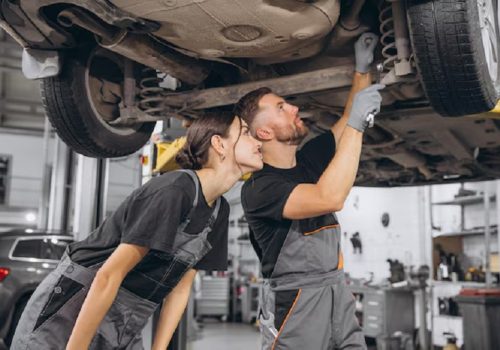Road-Trip Ready: A 15-Minute Jeep/SUV Health Checklist Before You Pack the Kids
Family road trips should feel exciting—not uncertain. Before the snacks, playlists, and backseat games, give your Jeep or SUV a quick, systematic once-over. This 15-minute checklist focuses on safety, comfort, and the small details that prevent big headaches on the highway.
1) Tires & Pressure (3 minutes)
Start where the rubber meets the road.
- PSI: Check all four tires—and the spare—against the door-jamb spec. Underinflation builds heat and kills MPG; overinflation amplifies bumps and reduces traction.
- Tread: Use the coin test or look for wear bars. Uneven wear (inner/outer edges, cupping) hints at alignment issues.
- Debris: Brush out stones from the shoulder sipes; they’re noisy and can cause slow leaks.
- Lug torque: If wheels were recently off, confirm proper torque to avoid vibration and rotor warping.
2) Brakes & Pedal Feel (1 minute)
With the engine on, press the pedal. It should feel firm, not spongy.
- Listen: Lightly roll and brake; squeal may indicate pad glazing, while grinding suggests low pad material.
- Parking brake: Engage/disengage to verify confident hold on a mild incline.
3) Fluids at a Glance (4 minutes)
Pop the hood and work left to right to avoid missing anything.
- Engine oil: Check level and color via dipstick; top up only with the correct spec.
- Coolant: Inspect the reservoir level when the engine is cool; look for crusting around hoses or the cap.
- Brake fluid: Level between MIN and MAX; dark fluid might warrant a flush soon.
- Windshield washer fluid: Top off—clear glass reduces fatigue and keeps eyes on the road.
- Transmission (if serviceable): Many modern Jeep Cherokees are “sealed,” but if yours has a dipstick, check hot and level per the manual. Any delayed engagement or shudder calls for professional inspection.
4) Belts, Hoses & Leaks (1 minute)
- Belts: Quick visual for fraying or cracking.
- Hoses: Squeeze gently; they should feel firm, not mushy.
- Underbody scan: Peek beneath for fresh drips or dampness along the oil pan, transmission, or cooler lines.
5) Battery & Charging (2 minutes)
Electrical gremlins love long drives.
- Terminals: Ensure clean, tight connections. Corrosion (white/green buildup) can cause no-start surprises at gas stops.
- Crank test: If starts feel sluggish or lights dim noticeably at idle with A/C on, consider testing at a parts store before you leave.
6) Lights, Wipers & Glass (1 minute)
- Exterior lights: Headlights (low/high), turn signals, brake lights, and hazards. Ask a helper or use reflections.
- Wipers: No streaks or chatter; replace blades if they smear.
- Glass: Clean inside and out—night glare and bug splatter compound driver fatigue.
7) Cabin Comfort & Safety (2 minutes)
Happy passengers = calmer driver.
- HVAC: Verify strong A/C and heat across vents; fog-prone climates benefit from a quick defrost test.
- Seats & restraints: Confirm car-seat anchors (LATCH) are tight, headrests positioned, and belts untwisted.
- Noise check: A new hum, thump, or vibration at 45–65 mph is a cue to investigate before the interstate.
8) Cargo, Roof & Hitch (1 minute)
- Load plan: Heavy items low and forward for stability; keep essentials accessible (snacks, wipes, emergency kit).
- Roof gear: Crossbars tight; straps secure with no loose tails.
- Hitch: Verify pin/clip, safety chains crossed, and wiring for trailer lights if towing.
Fast Fixes & Smart Spares to Stash
- Tire plug kit + portable 12V compressor: Air down on rough access roads, then air up for highway comfort—and plug small punctures without waiting for roadside assistance.
- Fuses & bulbs: A tiny kit saves late-night stops.
- Work gloves, shop towels, flashlight: Small comforts that make roadside checks efficient.
- Coolant and washer fluid: Top-offs on the go.
- Paper map or offline navigation: Cell service can vanish in the fun places.
Road Test: The Two-Minute Loop
Before loading the family, take a quick spin around the block.
- Steering straight? No pull or dead-zone wander.
- Braking smooth? No pulsation or side pull.
- Transmission behavior: Shifts should be crisp and consistent—no flare (RPM rises without speed) or shudder at light throttle.
- Listen: Windows cracked slightly help catch wheel-bearing growls or rhythmic thumps from tires.
When a Quick Check Says “See a Pro”
Some issues are better caught early:
- Persistent vibration at highway speeds even after proper tire pressure and torque.
- Brake warning lights (ABS, stability control) or a soft pedal.
- Transmission symptoms like delayed engagement, slipping, or new leaks.
- Cooling concerns: Gauge climbing on grades, sweet smell (coolant), or visible steam.
If your checklist flags something you can’t resolve in the driveway, prioritize Jeep Cherokee repair before the trip. Solving a small leak or alignment issue now beats managing a breakdown with kids and luggage in mid-July traffic.
Final Pack-and-Go Tips
- Fuel strategy: Fill up the night before; fewer morning stops keep momentum (and moods) high.
- Snack and trash plan: Sealable containers and a small bin maintain cabin sanity.
- Stretch schedule: Plan a 10-minute stop every 2–3 hours; it helps alertness and reduces “Are we there yet?” frequency.
- Share the checklist: Keep this routine on your phone. Repeating it before every trip builds confidence and catches problems when they’re still cheap.
Fifteen focused minutes can transform road-trip stress into highway certainty. With a quick tire/fluids/electrics sweep and a short road test, your SUV is set to carry the most precious cargo you own—safely, comfortably, and drama-free.





